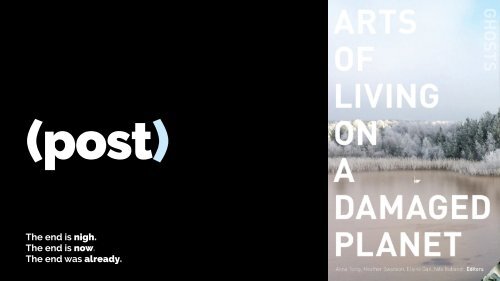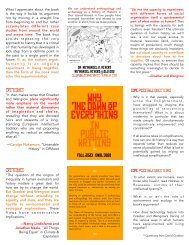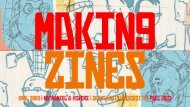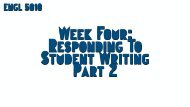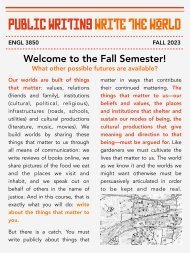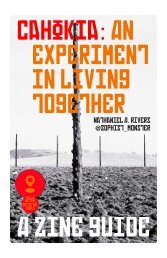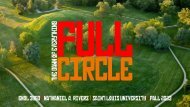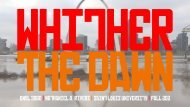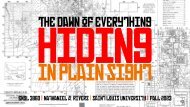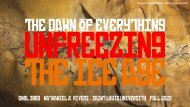ENGL 6040: Arts of Living on a Damaged Planet: Ghosts Keynote (SP22)
Create successful ePaper yourself
Turn your PDF publications into a flip-book with our unique Google optimized e-Paper software.
(post)<br />
The end is nigh. <br />
The end is now. <br />
The end was already.
“<br />
In the end Thomas had saved a world, just not the world (Read 113).<br />
Untitled, J<strong>on</strong> Read, 2021<br />
(post)
haunted <br />
landscapes<br />
The Santa Ana winds in Southern California, NASA<br />
“<br />
To track the histories that make multi species<br />
livability possibly, it is not enough to watch lively<br />
b<strong>on</strong>es. Instead, we must wander through<br />
landscapes, where assemblages <str<strong>on</strong>g>of</str<strong>on</strong>g> the dead<br />
gather together with the living (Gan + Tsing +<br />
Swans<strong>on</strong> + Bubandt G5).<br />
C<strong>on</strong>sidered through ghosts and weeds, worlds<br />
have ended many times before. Endings come<br />
with the death <str<strong>on</strong>g>of</str<strong>on</strong>g> a leaf, the death <str<strong>on</strong>g>of</str<strong>on</strong>g> a city, the<br />
death <str<strong>on</strong>g>of</str<strong>on</strong>g> a friendship, the death <str<strong>on</strong>g>of</str<strong>on</strong>g> small promises<br />
and small stories (Gan + Tsing + Swans<strong>on</strong> + {Bubandt G6)?<br />
(post)
haunted <br />
landscapes<br />
Discarded tires line the Tijuana River bed. Chris St<strong>on</strong>e<br />
“<br />
The movement <str<strong>on</strong>g>of</str<strong>on</strong>g> things. Things like tires. Let’s<br />
take tires. Trees and tires and tomatoes all matter<br />
here, all c<strong>on</strong>tribute to a shaping <str<strong>on</strong>g>of</str<strong>on</strong>g> the landscape.<br />
But it is to tires and tomatoes that I will now turn.<br />
Tires are everywhere in this cany<strong>on</strong>. Tomatoes are<br />
not so much in evidence, but <strong>on</strong> this visit, I find<br />
two small tomato plants. It is in the commingling<br />
<str<strong>on</strong>g>of</str<strong>on</strong>g> tires and tomatoes that I begin to find some <str<strong>on</strong>g>of</str<strong>on</strong>g><br />
the answers to the questi<strong>on</strong> <str<strong>on</strong>g>of</str<strong>on</strong>g> cany<strong>on</strong>s and<br />
gardens (Stern G23).<br />
(post)
haunted <br />
landscapes<br />
“<br />
I would never have thought that paved roads<br />
might be the key to tomatoes. But so l<strong>on</strong>g as the<br />
boundary between the road and the vegetable<br />
patch is permeable, the potential <str<strong>on</strong>g>of</str<strong>on</strong>g> yet another<br />
landscape unfolds, <strong>on</strong>e in which vegetables and<br />
people and n<strong>on</strong>native trees cohabit in a<br />
reshaped ecology, <strong>on</strong>e in which c<strong>on</strong>tinuity<br />
between the cany<strong>on</strong> and the estuary is preserved<br />
and tomatoes might serve to protect the<br />
endangered species in the wetlands (Stern G26).<br />
It is like this: a slow and Sisyphean project, a slow<br />
{changing <str<strong>on</strong>g>of</str<strong>on</strong>g> the landscape (Stern G28).<br />
(post)
in the midst <br />
<str<strong>on</strong>g>of</str<strong>on</strong>g> damage<br />
footprints <str<strong>on</strong>g>of</str<strong>on</strong>g> <br />
the dead<br />
what remains<br />
“Haunted Forest” by Michael Zheng<br />
(post)
in the midst <br />
<str<strong>on</strong>g>of</str<strong>on</strong>g> damage<br />
“<br />
I teased him, “How can you study something<br />
you can’t sense?” <br />
“The most comm<strong>on</strong> truism about radiati<strong>on</strong> is<br />
that humans cannot sense it,” Kupny replied, “but<br />
that is not true. With a dosimeter, you can hear<br />
radiati<strong>on</strong>. With a camera, you can see it. If the<br />
levels are high enough, you can taste it <strong>on</strong> your<br />
t<strong>on</strong>gue. It tastes metallic.” <br />
“And feel it?” <br />
Kupny nodded in affirmati<strong>on</strong>. After forty<br />
years in radioactive fields, he said, he can sense<br />
decaying atoms (Brown G40).<br />
An interior view shows the house in the aband<strong>on</strong>ed village <str<strong>on</strong>g>of</str<strong>on</strong>g> Zalissya near the<br />
Chernobyl Nuclear Power Plant, Ukraine, April 12, 2021. Reuters.<br />
(post)
in the midst <br />
<str<strong>on</strong>g>of</str<strong>on</strong>g> damage<br />
Islands <str<strong>on</strong>g>of</str<strong>on</strong>g> Aband<strong>on</strong>ment: <br />
Nature Rebounding in the <br />
Post-Human Landscape<br />
“<br />
I shut my eyes, feeling cold fingers touching my<br />
face, and visualize the radiati<strong>on</strong> washing over me,<br />
bathing me in a current <str<strong>on</strong>g>of</str<strong>on</strong>g> which I am <strong>on</strong>ly<br />
abstractly aware. Whose existence is a matter <str<strong>on</strong>g>of</str<strong>on</strong>g><br />
faith. It is <strong>on</strong>e thing to understand the c<strong>on</strong>cept in a<br />
lecture, I think. Another altogether to comprehend<br />
your body at the mercy <str<strong>on</strong>g>of</str<strong>on</strong>g> it. It takes a certain,<br />
mystical, frame <str<strong>on</strong>g>of</str<strong>on</strong>g> mind; <strong>on</strong>e I am not unfamiliar<br />
with. I surrender myself to it, to its greater power. I<br />
feel my boundaries blur, grow indistinct.<br />
Gamma rays pass through me <strong>on</strong> their way<br />
elsewhere. <br />
After a minute or so, I step away, and hear the<br />
siren fall to a crackle. I feel nothing. I think: I am<br />
not afraid (Flyn 78).<br />
(post)
in the midst <br />
<str<strong>on</strong>g>of</str<strong>on</strong>g> damage<br />
“<br />
These points <str<strong>on</strong>g>of</str<strong>on</strong>g> light are not representati<strong>on</strong>s.<br />
They are energy embodied. The specks are n<strong>on</strong>e<br />
other than cesium, plut<strong>on</strong>ium, and uranium selfportraits<br />
(Brown G41).<br />
This kind <str<strong>on</strong>g>of</str<strong>on</strong>g> creative, sp<strong>on</strong>taneous labor, for<br />
which Kupny, the artisan, takes no payment,<br />
{announces his freedom (Brown G41).<br />
(post)
in the midst <br />
<str<strong>on</strong>g>of</str<strong>on</strong>g> damage<br />
“<br />
I use the term “aesthetic” in a n<strong>on</strong>technical way<br />
to discuss things that appeal to the senses, things<br />
that evoke or capture feelings and resp<strong>on</strong>ses. I<br />
want to think <str<strong>on</strong>g>of</str<strong>on</strong>g> aesthetics, in part, in angiosperm<br />
terms, that is, in terms <str<strong>on</strong>g>of</str<strong>on</strong>g> lures that both entice<br />
<strong>on</strong>e’s attenti<strong>on</strong> and <str<strong>on</strong>g>of</str<strong>on</strong>g>fer rewards. (Rose G53).<br />
(post)
in the midst <br />
<str<strong>on</strong>g>of</str<strong>on</strong>g> damage<br />
“<br />
Instead, by foregrounding the excepti<strong>on</strong>al<br />
d a m a g e t h a t h u m a n s a re c a u s i n g , t h e<br />
Anthropocene shows us the need for radically<br />
reworked forms <str<strong>on</strong>g>of</str<strong>on</strong>g> attenti<strong>on</strong> to what marks the<br />
human species as different (Rose G55).<br />
We are called to acknowledge that in the midst<br />
<str<strong>on</strong>g>of</str<strong>on</strong>g> all we cannot choose, we also make choices<br />
{(Brown G61).<br />
(post)
footprints <str<strong>on</strong>g>of</str<strong>on</strong>g> <br />
the dead<br />
“<br />
The reintroducti<strong>on</strong> reinstated a series <str<strong>on</strong>g>of</str<strong>on</strong>g> trophic<br />
cascades with important ecosystem effects.<br />
Wolves began to limit the populati<strong>on</strong> size and<br />
space use <str<strong>on</strong>g>of</str<strong>on</strong>g> American elk (C. canadensis) and <str<strong>on</strong>g>of</str<strong>on</strong>g><br />
the competing, but smaller, coyote (Canis latrans).<br />
Hereby, the wolf reintroducti<strong>on</strong> had str<strong>on</strong>g<br />
indirect c<strong>on</strong>sequences for vegetati<strong>on</strong> dynamics<br />
(Svenning G74-5).<br />
The aftermath <str<strong>on</strong>g>of</str<strong>on</strong>g> the atomic bomb in Hiroshima <strong>on</strong> Aug. 6, 1945. U.S. Army<br />
(post)
footprints <str<strong>on</strong>g>of</str<strong>on</strong>g> <br />
the dead<br />
“<br />
The dense temperate forests imagined to have<br />
covered much <str<strong>on</strong>g>of</str<strong>on</strong>g> Europe and eastern North<br />
America prior to agriculture could therefore be a<br />
sign not <str<strong>on</strong>g>of</str<strong>on</strong>g> “untouched” wilderness but <str<strong>on</strong>g>of</str<strong>on</strong>g> vast<br />
extincti<strong>on</strong>s (Svenning G76).<br />
(post)
footprints <str<strong>on</strong>g>of</str<strong>on</strong>g> <br />
the dead<br />
“<br />
This hierarchical understanding <str<strong>on</strong>g>of</str<strong>on</strong>g> life, which<br />
defines “progress” as a linear movement from the<br />
so-called simple to the complex, has l<strong>on</strong>g<br />
haunted biological inquiry (Hejnol G87).<br />
(post)
footprints <str<strong>on</strong>g>of</str<strong>on</strong>g> <br />
the dead<br />
“<br />
But what, after all, is complexity? If there is such a<br />
thing as “complexity,” it is an adaptati<strong>on</strong> to<br />
specific ecological c<strong>on</strong>diti<strong>on</strong>s, not the outcome<br />
<str<strong>on</strong>g>of</str<strong>on</strong>g> a teleological process (Hejnol G96).<br />
The empirical is always stranger than we<br />
{imagined (Hejnol G100).<br />
(post)
footprints <str<strong>on</strong>g>of</str<strong>on</strong>g> <br />
the dead<br />
“<br />
E n t a n g l e m e n t s a r e t h e o n t o l o g i c a l<br />
inseparability <str<strong>on</strong>g>of</str<strong>on</strong>g> intra-acting agencies.<br />
Naturalcultural phenomena are entanglements, the<br />
sedimented effects <str<strong>on</strong>g>of</str<strong>on</strong>g> a dynamics <str<strong>on</strong>g>of</str<strong>on</strong>g> iterative intraactivity,<br />
where intra-acti<strong>on</strong>s (c<strong>on</strong>tra interacti<strong>on</strong>s<br />
do not assume separability, but rather) cut<br />
together-apart, differentiate-entangle. Phenomena<br />
are specific material relati<strong>on</strong>s <str<strong>on</strong>g>of</str<strong>on</strong>g> the <strong>on</strong>going<br />
differentiating <str<strong>on</strong>g>of</str<strong>on</strong>g> the world, where “material”<br />
needs to be understood as iteratively c<strong>on</strong>stituted<br />
through force relati<strong>on</strong>s. Phenomena are not located<br />
in space and time; rather, phenomena are<br />
material entanglements enfolded and threaded<br />
through the spacetimemattering <str<strong>on</strong>g>of</str<strong>on</strong>g> the universe.<br />
Entanglements are the iterative intra-active<br />
(re)c<strong>on</strong>fi g u r i n g s a n d e n f o l d i n g s o f<br />
spacetimemattering (Barad G111).<br />
(post)
footprints <str<strong>on</strong>g>of</str<strong>on</strong>g> <br />
the dead<br />
“<br />
As such, the mud volcano is a tragic and dystopic,<br />
but also illuminating, illustrati<strong>on</strong> <str<strong>on</strong>g>of</str<strong>on</strong>g> the<br />
Anthropocene, c<strong>on</strong>venti<strong>on</strong>ally described as the<br />
geological period in which human activity<br />
exceeds the forces <str<strong>on</strong>g>of</str<strong>on</strong>g> nature. What better<br />
example <str<strong>on</strong>g>of</str<strong>on</strong>g> such excess than if humans caused a<br />
disastrous volcanic erupti<strong>on</strong>? The Ind<strong>on</strong>esian mud<br />
volcano, however, also highlights another, equally<br />
important and unsettling feature <str<strong>on</strong>g>of</str<strong>on</strong>g> the<br />
A n t h ro p o c e n e , n a m e ly, t h e i n c r e a s i n g<br />
impossibility <str<strong>on</strong>g>of</str<strong>on</strong>g> distinguishing human from<br />
n<strong>on</strong>human forces, the anthropos from the geos<br />
(Bubandt G122).<br />
(post)
what remains<br />
“<br />
I prefer to think <str<strong>on</strong>g>of</str<strong>on</strong>g> “Anthropocenes” as<br />
irreducibly multiple rather than <str<strong>on</strong>g>of</str<strong>on</strong>g> a singular<br />
“Anthropocene.” We can remember the<br />
sustainable Anthropocene <str<strong>on</strong>g>of</str<strong>on</strong>g> peasant chestnut<br />
cultivati<strong>on</strong> over the last fifteen hundred years or<br />
the less hopeful Anthropocene <str<strong>on</strong>g>of</str<strong>on</strong>g> chestnut<br />
aband<strong>on</strong>ment in the wake <str<strong>on</strong>g>of</str<strong>on</strong>g> industrializati<strong>on</strong> and<br />
globalizati<strong>on</strong> over the last two hundred. Both are<br />
Anthropocenes (Matthews G154).<br />
Evan McGlinn for The New York Times<br />
(post)
what remains<br />
“Entire worlds established, and the worlds aren’t<br />
static. While the interacti<strong>on</strong>s within each extant<br />
Xanthoparmelia m a y p l a y o u t a l m o s t<br />
imperceptibly, they will influence the growth <str<strong>on</strong>g>of</str<strong>on</strong>g><br />
the species within, creating a dynamic interior<br />
ecology. And whether it is the interacti<strong>on</strong>s or<br />
something else shaping the evoluti<strong>on</strong> <str<strong>on</strong>g>of</str<strong>on</strong>g> aging, it’s<br />
clear these dynamic worlds will persist for a very<br />
l<strong>on</strong>g time (Pringle G166).<br />
(post)
“<br />
What is at stake in these essays is not what the<br />
Anthropocene is but how it will be lived (Pratt<br />
G170).<br />
what remains<br />
For most <str<strong>on</strong>g>of</str<strong>on</strong>g> the writers here, the questi<strong>on</strong> <str<strong>on</strong>g>of</str<strong>on</strong>g> how<br />
to live the Anthropocene is inseparable from the<br />
{questi<strong>on</strong> <str<strong>on</strong>g>of</str<strong>on</strong>g> how to write it (Pratt G170).<br />
(post)
“<br />
These writers are not discovering Anthropocenic<br />
landscapes; they are creating them, in language.<br />
They are realized in the aesthetic (vs. anesthetic)<br />
resp<strong>on</strong>ses <str<strong>on</strong>g>of</str<strong>on</strong>g> the reader, driven by the artistic<br />
principle <str<strong>on</strong>g>of</str<strong>on</strong>g> estrangement, the making <str<strong>on</strong>g>of</str<strong>on</strong>g> w<strong>on</strong>der<br />
(Pratt G172).<br />
what remains<br />
Life perpetuates itself through orchestrated<br />
{aesthetic display (Pratt G173).<br />
(post)
(post)<br />
The end is nigh. <br />
The end is now. <br />
The end was already.


